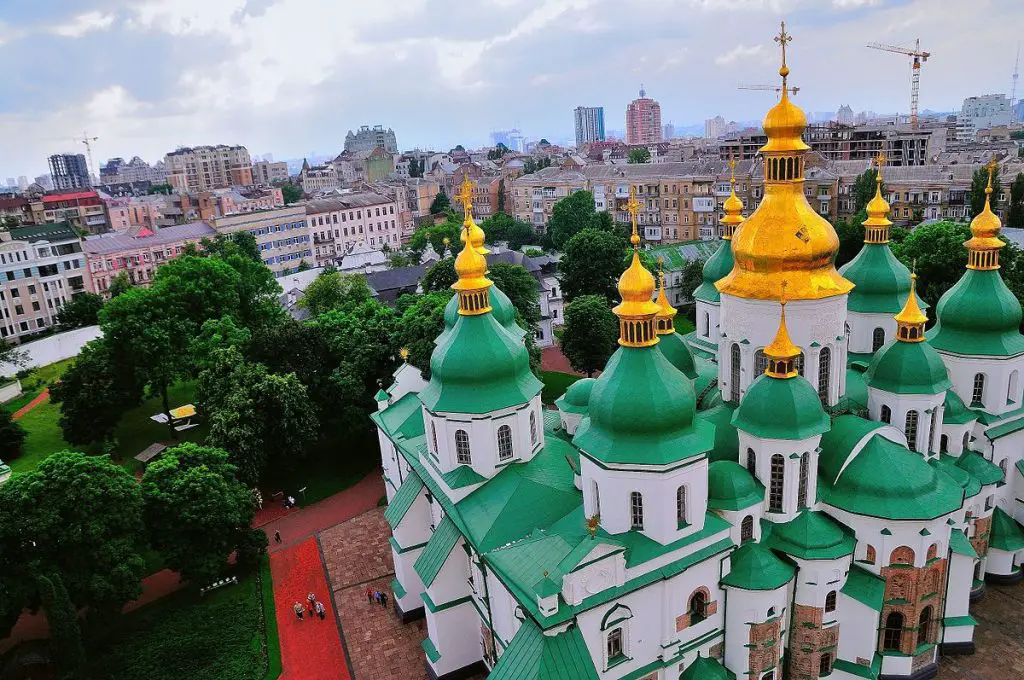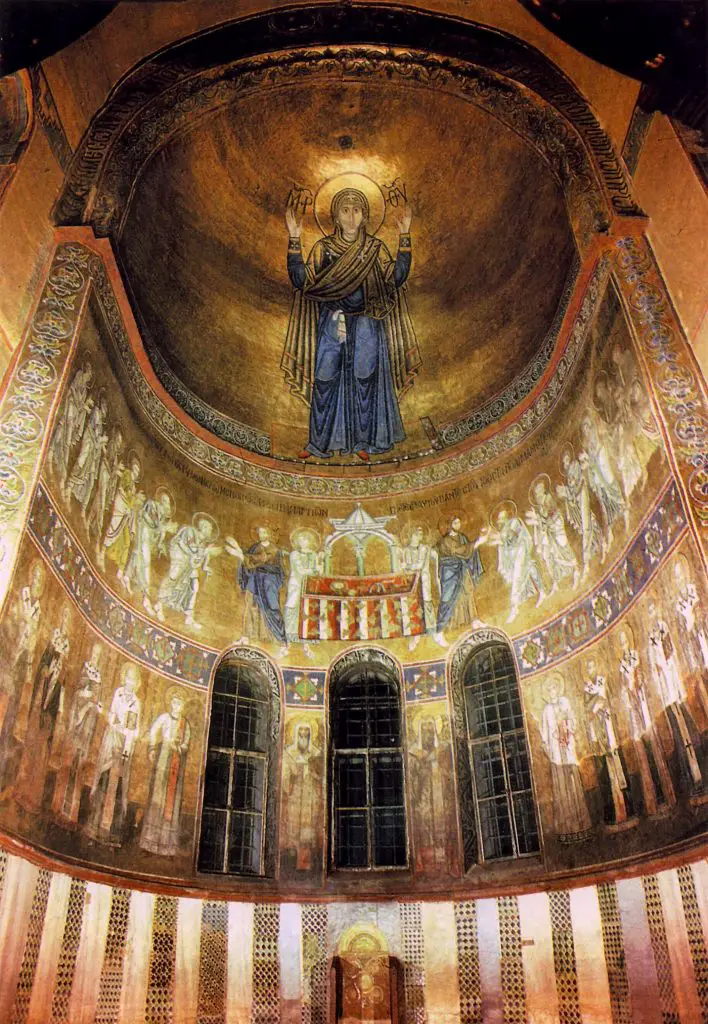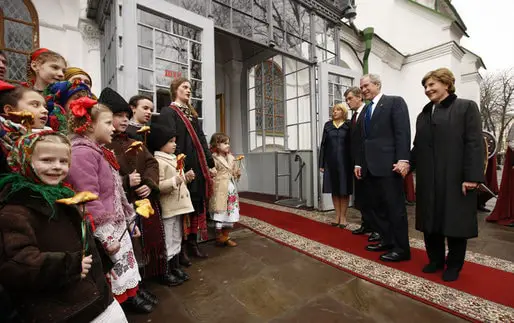Near the center of the city, St. Sophia’s Cathedral is maintained by the Ukrainian government as a grand and beautiful reminder of the past. Originally founded in 1011 A.D., when Kyiv was still the capital of Kyivan Rus’, it was an early and grand celebration of the state’s official adoption of Christianity in 988. The cathedral, now a museum, remains one of three UNESCO world heritage sites in Kyiv. It has managed to withstand the sands of time, but not without struggles.
The Resiliance of St. Sophia’s
By Samantha Dunlap

The cathedral’s inspiration – for its name and partly for its construction – come from the Hagia Sophia of Istanbul. The richness and splendor of that city’s Christian institutions left a striking impression on the Slavs who visited it and is said to have influenced Prince Vladimir’s historic decision to convert.
Hard times began in 1240, when the Mongols razed most of the ancient city. Much of St. Sophia’s surrounding grounds were destroyed, though the bell tower and central dome survived. St. Sophia’s would see raids, religious disputes, decaying ceilings, and art thieves before it was repaired in the 17th century.
These repairs restored the church and also gave it a new styling of “Ukrainian Baroque,” rather than the Western styles used previously. The intense, bright colors contrast with simple lines and forms. This makes Ukrainian style unique from the more ornate, dramatic Byzantine cathedrals. Most Ukrainian Baroque churches are filled with golden alters that mirror the golden roofs.
The cathedral narrowly escaped doom during the Soviet’s religious purges. Plans to take down the church with its gleaming gold tops and replace it with a grey complex would have completely changed the Kyiv horizon. Although many beautiful churches, some even on the same street, were destroyed, St. Sophia’s was spared and instead became a museum of architecture.
This was a strategy often used in the USSR by those who sought to save the Orthodox heritage of their country. There are several reasons why the church was spared. Many historians and artists argued on its behalf as a historical structure and object of beauty if not a religious institution. A more practical reason, however, is likely that the Soviets found that they lacked the funds to replace the building on the hilly landscape.
Inside St. Sophia’s

By Samantha Dunlap
Like much of Europe, Ukraine sits at the brink of old and new. Its capital, Kyiv, is a series of often anachronistic contrasts — new cars drive on worn cobblestone roads, metro stations sit beside landmarks that date back hundreds of years, and the smell of heavy cigarette smoke is nearly obscured by the flower stands on every street corner. The grandeur of its famous Orthodox architecture momentarily distracts from the hustle and bustle of what has become Europe’s seventh largest city. These juxtapositions make Kyiv interesting, and nowhere is that better demonstrated than Kyiv’s oldest standing church.
Today, St. Sophia’s glistening golden bell tower can be seen from miles away— it grows no less impressive the closer you get. Passing the gates of the surrounding wall, the visitor then walks through a beautiful garden and courtyard filled with flowers and trees. Even with the digital cameras and tourists’ baseball caps that now dominate this area, there is the unmistakable presence of history. As soon as you enter the church itself, you’re greeted with the incredible, centuries-old frescoes and mosaics. At the center, above the altar, sits the Virgin Oran, or Virgin Mary, one of the original surviving pieces from the 11th century. This particular Oran has survived so long that many in the Orthodox religion believe it to be indestructible, and that as long as the nearly 20-foot tall mosaic is standing, it protects Kyiv itself from destruction.
In addition to the formidable Mary, there are striking portraits of the Yaroslav family that have also survived from the 11th century. They are faded, but an incredible reminder of Kyiv’s grand past nonetheless. It’s so easy to forget that the figures in these portraits actually existed outside of the novel of history we learn. Thinking about this and looking at the paintings that are hundreds and hundreds of years old put everything in perspective for me. Beyond this, nearly every wall in the church is covered in vibrantly colored paintings that showcase both Ukrainian and Byzantine influences.
The individual paintings and the structure as a whole can be better understood by hiring a guide from the facility. They are available in English as well as Ukrainian and Russian. English-speaking guides can be in short supply and high demand so you might try to phone ahead and make a reservation. There are also inexpensive audio guides available in multiple languages including English.

As far as museums go, St. Sophia’s is obviously niche, focusing only on preserving and displaying what is actually in and around the cathedral. This makes it fairly easy to follow. The entire experience is focused on providing a deep understanding of this specific site, and its mark on the region. The paintings, frescoes, and mosaics can seem overwhelming at first in their sheer number and beauty. You have to think of them as a unified whole, contributing to a place meant to be used as a space for reflection and worship. The accessibility of the historical structure also allows the viewer to view the church and art from multiple angles: from the floor, the spiral staircase, or from the balcony, from which one can make particularly striking eye contact with the beautiful Virgin Oran, a completely different experience from viewing her from the ground level. The bell tower is open to provide truly spectacular views of the city, tying the church to the surrounding area and providing yet another contrast: standing in a bell tower from the 11th century, one sees billboards and skyscrapers.
The Museum Complex of St. Sophia’s
By Samantha Dunlap
There is a model of the cathedral and grounds as they looked in the 11th century on the first floor of the cathedral. This shows a city in stark contrast to modern Kyiv but many of the buildings on the cathedral grounds have either survived or been reconstructed.
For instance, the refectory still stands and has been turned into a more traditional museum. While not incredibly modern and with comparatively little technology, it’s interesting and not difficult to follow. Inside is an in depth historical overview with images of what the original grounds most likely looked like and a recording of all the restoration the site has gone through. The small museum is completely devoted to the immediate grounds, giving it a brevity and immediacy that many museums lack.
St. Sophia’s itself only feels ancient when one recalls its long history. It has been beautifully restored and today stands proud at the center of Kyiv, an obvious and memorable piece of the skyline. In fact, despite being a museum, it still plays a role in the city’s modern social, political, and religious life.
A fair amount of St. Sophia’s budget comes from given by UNESCO, which provided over $74,000 in 2019. Although a UNESCO site, which should not have any active religious ceremonies, the church has been utilized for church purposes since receiving its UNESCO status. Most recently, after the Ukrainian Orthodox Church was granted independence from the Russian Orthodox Church by the Patriarch of Contantinople, the head of the new church was coronated in St. Sophia. There was outrage among the Russian Orthodox in part as they feared that the church, which has been an important part of the history of slavic Orthodoxy as a whole and which is currently shared, neutral ground as a state museum, was offered with special access to the new religion. There is some talk of restoring it to an active church, as the Pershka Lavra Cathedral is on the other side of the city, which would likely be met with considerable opposition from both Russia and local Russian Orthodox faithful.
There is an aura on the grounds as a whole, from its lush courtyards to soaring bell tower. How well it’s maintained certainly contributes to this. As both a Complex of Culture Heritage for UNESCO since 1990, and an area of importance for the Ministry of Culture in Ukraine, it has established itself as a necessary piece of Kyiv. As a UNESCO site, the goal of St. Sophia’s, both as a museum and a historical site, is to preserve history. It has the largest number of intact paintings and frescoes from its time period, and is a brilliant representation of Ukrainian Baroque architecture. Having stood through both Mongol invasions and Soviet purges, St. Sophia’s is a survivor that is worth a visit and worth keeping.
A Visit to St. Sophia’s with SRAS and Novamova in 2019
By Jonah Helwig
Kyiv’s skyline is riddled with beautiful architecture, Soviet-style apartment buildings, bridges, and much more. Most iconic out of all this, however, are the classic domes and bell tower of St. Sophia’s Cathedral. I had the opportunity to visit this landmark as part of the included cultural package with my SRAS/Novamova program in Kyiv. I discovered it to be one the most beautiful churches I have ever set foot in. Never have I been in a building so old and filled wall-to-wall with history. The gorgeous frescoes and mosaics painted a picture not only of the essence of Eastern Orthodoxy but also the history of Ukraine.
St. Sophia’s Cathedral was built in the 11th century and has stood the test of time to remain one of the key symbols of Ukraine. The church is no longer active and serves as a museum and Ukrainian heritage site. Every interior wall is covered in beautiful frescos of saints and holy men and women of the church. The central icon of the church is the enormous mosaic of the Virgin Mary. The mosaic stands nearly twenty feet tall, taking up the entire ceiling dome. Legend has it that this mosaic offers is a patron protectress of Kyiv; so long as the mosaic stands, Kyiv shall not fall.
The cathedral is at the very heart of Kyiv and is a focal point of the city. The entrance to the cathedral grounds is through the bell tower directly in front of the cathedral. The tower stands at almost 250 feet and is ornately decorated in the Ukrainian Baroque style. Accordingly, the tower is mostly a cool blue with white accents. While on our tour, I got the chance to climb the bell tower. It was quite a hike and I was gasping for breath by the time we reached the first landing. It seemed like the stairs went on forever. After a long hike up, I finally reached the top landing, which gives amazing views of Kyiv’s historic center in all its glory.
St. Sophia’s Cathedral and its bell tower are staple landmarks of Kyiv. I passed the cathedral almost every day during my time there. Whenever I got lost in the city, which happened on multiple occasions, I knew I could find my way home if I could find St. Sophia’s Cathedral first. The cathedral and bell tower are two of the most ornate and beautiful structures in Kyiv and it is a must visit for anyone coming to the city.
St. Sophia’s Since the War Began
By SRAS Staff
St. Sophia’s, which sits in the heart of Kyiv, has been of major concern in the ongoing attacks since the start of the war in Ukraine. Miraculously, the building has not sustained direct, major damage as of May, 2024. However, it has been hit with shrapnel from nearby explosions and experts are concerned that the shockwaves of the explosions may be causing long-term damage to the structure and its foundations.
Amazingly, restoration work to the building has continued even as the war has raged. The seven iconic crosses that top St. Sophia’s had become badly corroded over the centuries. Each has now been taken down, treated, and returned to its proper place.
The UNESCO World Heritage Committee has also highlighted the danger facing St. Sophia’s Cathedral by placing the historic building on its official list of World Heritage sites in danger. Also now listed there are the Kyiv-Pechersk Lavra, also known as the Monastery of the Caves, and Lviv’s historic medieval city center.
You’ll Also Love

Syrniki: Not Your Average Cheese Cake
Syrniki (Сырники) are cottage cheese griddle cakes, sometimes called “cheese fritters” in English. They are generally fried in vegetable oil to create crispy-on-the-outside, soft-on-the-inside medallions of warm, creamy goodness. Drizzled with sour cream, condensed milk, and/or jam, and served for breakfast or dessert, syrniki are particularly beloved in Russia, Ukraine, Poland, Belarus, and the Baltics. […]

Medovukha: The King of Slavic Honey Drinks
Medovukha (медовуха) is a Slavic honey-based alcoholic beverage. It is one of the most recent and perhaps the best known iteration of a long evolutionary tree of Russian honey-based beverages that can be traced all the way back to the Old Slavs. In Russia today, some argue that a return to these honey drinks, which […]

Okroshka: A Refreshing Summer Soup
Okroshka (Окрошка) is a cold soup that probably originated in the Volga region of Russia. Because of its light, refreshing taste, it is popularly served in summer. The soup usually consists of diced vegetables, eggs, and meats in a base of either kvass or kefir and is often garnished with sour cream. Best known in […]

Kvass! A Bubbly Black Bread Drink
Kvass (Квас) is sometimes referred to as “bread drink” or even “bread cider” in English. We recommend just sticking with the word “kvass,” though. Brewed from black or rye bread, the drink may come with a range of consistencies similar to those found in beer and a distinctly “bready” taste. The first recorded mention of […]

St. Panteleimon Cathedral & Feofaniya Park in Kyiv
Tucked away in the outskirts of Kyiv, in the Holiivs’ki district, lies St. Pantelemion’s Cathedral and Feofaniya Park. This place makes for a great day away from the hustle and bustle of the city. First, be sure to step inside and admire the beauty of St. Pantelemion’s Cathedral. When looking at the gorgeous iconography, don’t […]







